Analyzing Health Policies and Sociological Impacts: Report
VerifiedAdded on 2022/09/26
|9
|2355
|39
Report
AI Summary
This report provides a comprehensive analysis of health policies, addressing several key areas. It begins by explaining the importance of the policy cycle as a tool for developing new policies, highlighting its flexibility and iterative nature. The report then examines policy considerations for a national obesity health campaign, emphasizing the need for restrictions on discretionary foods, government support for healthy food choices, community-based initiatives, and nutrition education. Furthermore, it delves into sociological issues impacting individual health, such as socio-economic disparities, lack of opportunities, stress, and discrimination, and their effects on health outcomes. The report also differentiates between health policy and government policy documents, emphasizing that health policy is broader and influences various factors impacting health. Finally, it contrasts the 'new public health' approach with the old, noting the former's focus on contemporary health issues, the health of populations, and the incorporation of innovative technologies and methods. The report uses Australian examples and relevant research to support its arguments.
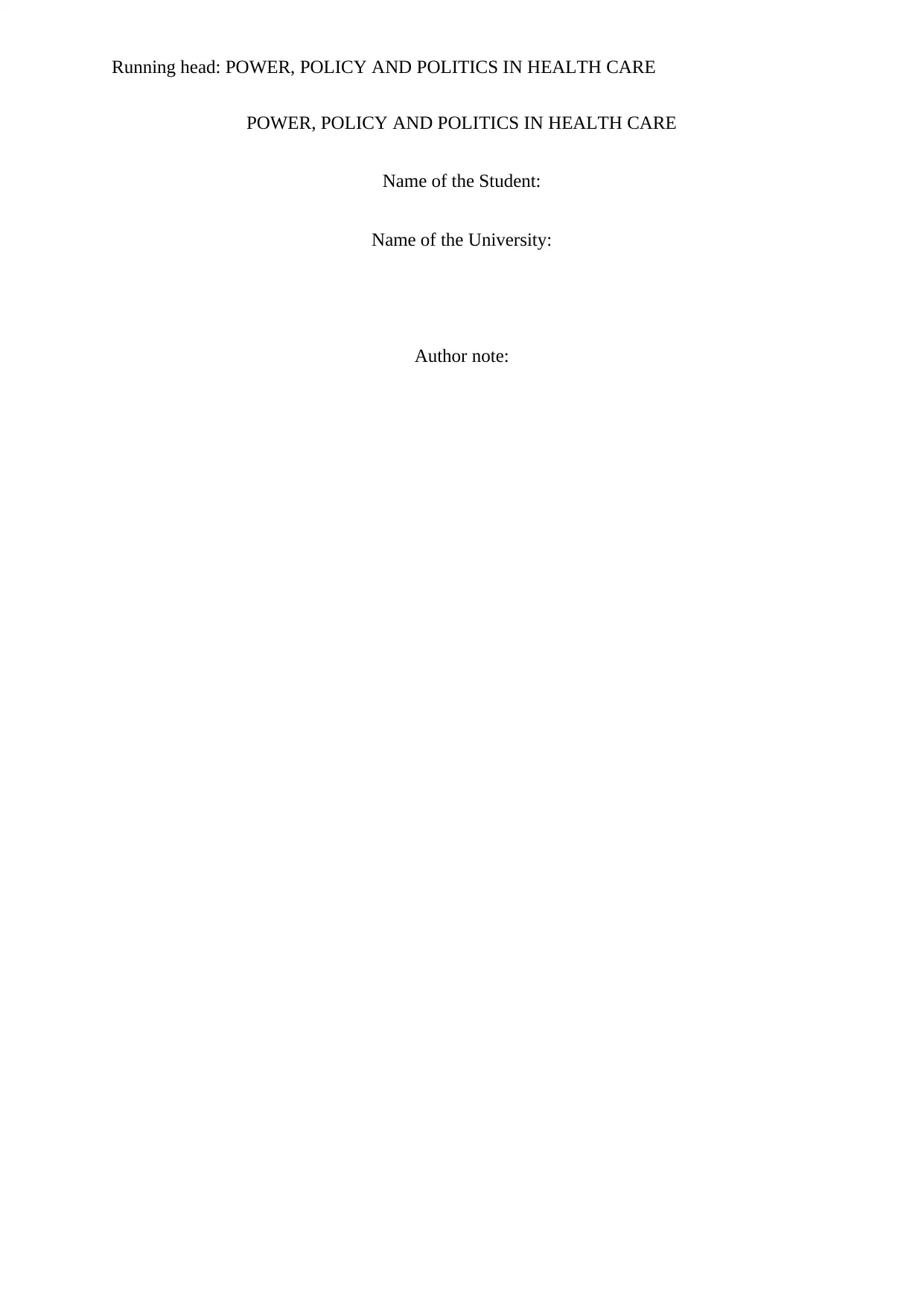
Running head: POWER, POLICY AND POLITICS IN HEALTH CARE
POWER, POLICY AND POLITICS IN HEALTH CARE
Name of the Student:
Name of the University:
Author note:
POWER, POLICY AND POLITICS IN HEALTH CARE
Name of the Student:
Name of the University:
Author note:
Paraphrase This Document
Need a fresh take? Get an instant paraphrase of this document with our AI Paraphraser
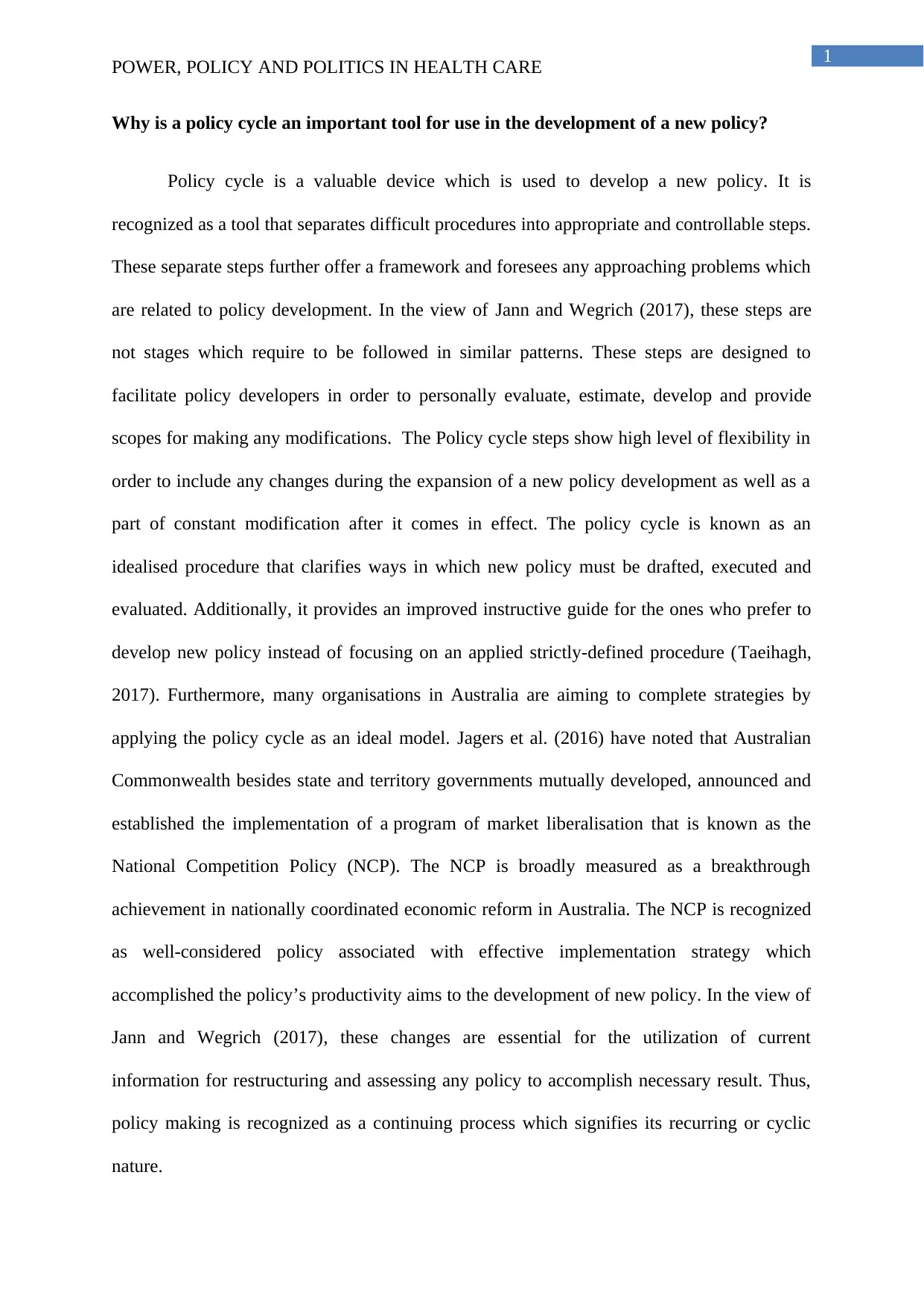
1
POWER, POLICY AND POLITICS IN HEALTH CARE
Why is a policy cycle an important tool for use in the development of a new policy?
Policy cycle is a valuable device which is used to develop a new policy. It is
recognized as a tool that separates difficult procedures into appropriate and controllable steps.
These separate steps further offer a framework and foresees any approaching problems which
are related to policy development. In the view of Jann and Wegrich (2017), these steps are
not stages which require to be followed in similar patterns. These steps are designed to
facilitate policy developers in order to personally evaluate, estimate, develop and provide
scopes for making any modifications. The Policy cycle steps show high level of flexibility in
order to include any changes during the expansion of a new policy development as well as a
part of constant modification after it comes in effect. The policy cycle is known as an
idealised procedure that clarifies ways in which new policy must be drafted, executed and
evaluated. Additionally, it provides an improved instructive guide for the ones who prefer to
develop new policy instead of focusing on an applied strictly-defined procedure (Taeihagh,
2017). Furthermore, many organisations in Australia are aiming to complete strategies by
applying the policy cycle as an ideal model. Jagers et al. (2016) have noted that Australian
Commonwealth besides state and territory governments mutually developed, announced and
established the implementation of a program of market liberalisation that is known as the
National Competition Policy (NCP). The NCP is broadly measured as a breakthrough
achievement in nationally coordinated economic reform in Australia. The NCP is recognized
as well-considered policy associated with effective implementation strategy which
accomplished the policy’s productivity aims to the development of new policy. In the view of
Jann and Wegrich (2017), these changes are essential for the utilization of current
information for restructuring and assessing any policy to accomplish necessary result. Thus,
policy making is recognized as a continuing process which signifies its recurring or cyclic
nature.
POWER, POLICY AND POLITICS IN HEALTH CARE
Why is a policy cycle an important tool for use in the development of a new policy?
Policy cycle is a valuable device which is used to develop a new policy. It is
recognized as a tool that separates difficult procedures into appropriate and controllable steps.
These separate steps further offer a framework and foresees any approaching problems which
are related to policy development. In the view of Jann and Wegrich (2017), these steps are
not stages which require to be followed in similar patterns. These steps are designed to
facilitate policy developers in order to personally evaluate, estimate, develop and provide
scopes for making any modifications. The Policy cycle steps show high level of flexibility in
order to include any changes during the expansion of a new policy development as well as a
part of constant modification after it comes in effect. The policy cycle is known as an
idealised procedure that clarifies ways in which new policy must be drafted, executed and
evaluated. Additionally, it provides an improved instructive guide for the ones who prefer to
develop new policy instead of focusing on an applied strictly-defined procedure (Taeihagh,
2017). Furthermore, many organisations in Australia are aiming to complete strategies by
applying the policy cycle as an ideal model. Jagers et al. (2016) have noted that Australian
Commonwealth besides state and territory governments mutually developed, announced and
established the implementation of a program of market liberalisation that is known as the
National Competition Policy (NCP). The NCP is broadly measured as a breakthrough
achievement in nationally coordinated economic reform in Australia. The NCP is recognized
as well-considered policy associated with effective implementation strategy which
accomplished the policy’s productivity aims to the development of new policy. In the view of
Jann and Wegrich (2017), these changes are essential for the utilization of current
information for restructuring and assessing any policy to accomplish necessary result. Thus,
policy making is recognized as a continuing process which signifies its recurring or cyclic
nature.
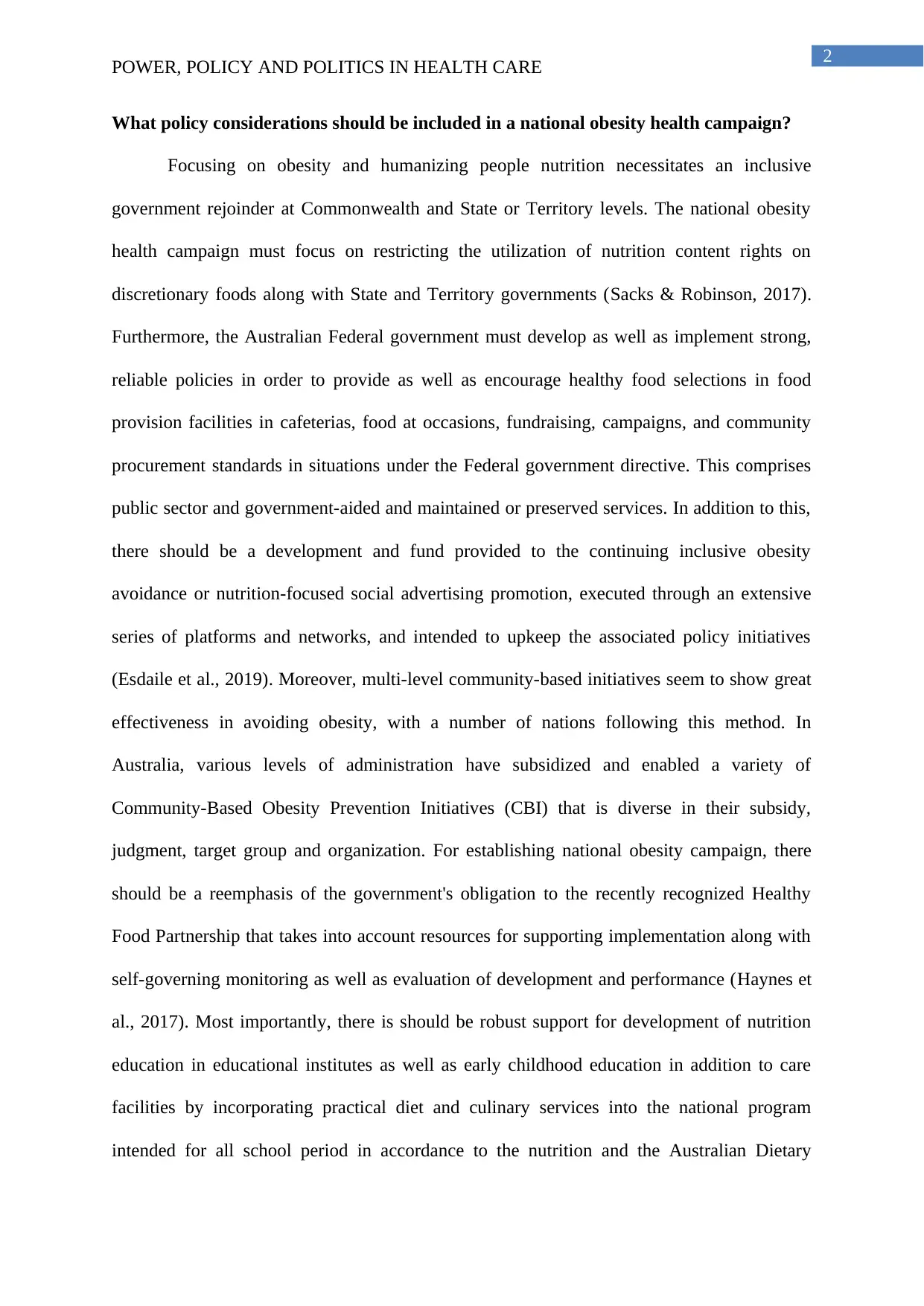
2
POWER, POLICY AND POLITICS IN HEALTH CARE
What policy considerations should be included in a national obesity health campaign?
Focusing on obesity and humanizing people nutrition necessitates an inclusive
government rejoinder at Commonwealth and State or Territory levels. The national obesity
health campaign must focus on restricting the utilization of nutrition content rights on
discretionary foods along with State and Territory governments (Sacks & Robinson, 2017).
Furthermore, the Australian Federal government must develop as well as implement strong,
reliable policies in order to provide as well as encourage healthy food selections in food
provision facilities in cafeterias, food at occasions, fundraising, campaigns, and community
procurement standards in situations under the Federal government directive. This comprises
public sector and government-aided and maintained or preserved services. In addition to this,
there should be a development and fund provided to the continuing inclusive obesity
avoidance or nutrition-focused social advertising promotion, executed through an extensive
series of platforms and networks, and intended to upkeep the associated policy initiatives
(Esdaile et al., 2019). Moreover, multi-level community-based initiatives seem to show great
effectiveness in avoiding obesity, with a number of nations following this method. In
Australia, various levels of administration have subsidized and enabled a variety of
Community-Based Obesity Prevention Initiatives (CBI) that is diverse in their subsidy,
judgment, target group and organization. For establishing national obesity campaign, there
should be a reemphasis of the government's obligation to the recently recognized Healthy
Food Partnership that takes into account resources for supporting implementation along with
self-governing monitoring as well as evaluation of development and performance (Haynes et
al., 2017). Most importantly, there is should be robust support for development of nutrition
education in educational institutes as well as early childhood education in addition to care
facilities by incorporating practical diet and culinary services into the national program
intended for all school period in accordance to the nutrition and the Australian Dietary
POWER, POLICY AND POLITICS IN HEALTH CARE
What policy considerations should be included in a national obesity health campaign?
Focusing on obesity and humanizing people nutrition necessitates an inclusive
government rejoinder at Commonwealth and State or Territory levels. The national obesity
health campaign must focus on restricting the utilization of nutrition content rights on
discretionary foods along with State and Territory governments (Sacks & Robinson, 2017).
Furthermore, the Australian Federal government must develop as well as implement strong,
reliable policies in order to provide as well as encourage healthy food selections in food
provision facilities in cafeterias, food at occasions, fundraising, campaigns, and community
procurement standards in situations under the Federal government directive. This comprises
public sector and government-aided and maintained or preserved services. In addition to this,
there should be a development and fund provided to the continuing inclusive obesity
avoidance or nutrition-focused social advertising promotion, executed through an extensive
series of platforms and networks, and intended to upkeep the associated policy initiatives
(Esdaile et al., 2019). Moreover, multi-level community-based initiatives seem to show great
effectiveness in avoiding obesity, with a number of nations following this method. In
Australia, various levels of administration have subsidized and enabled a variety of
Community-Based Obesity Prevention Initiatives (CBI) that is diverse in their subsidy,
judgment, target group and organization. For establishing national obesity campaign, there
should be a reemphasis of the government's obligation to the recently recognized Healthy
Food Partnership that takes into account resources for supporting implementation along with
self-governing monitoring as well as evaluation of development and performance (Haynes et
al., 2017). Most importantly, there is should be robust support for development of nutrition
education in educational institutes as well as early childhood education in addition to care
facilities by incorporating practical diet and culinary services into the national program
intended for all school period in accordance to the nutrition and the Australian Dietary
⊘ This is a preview!⊘
Do you want full access?
Subscribe today to unlock all pages.

Trusted by 1+ million students worldwide
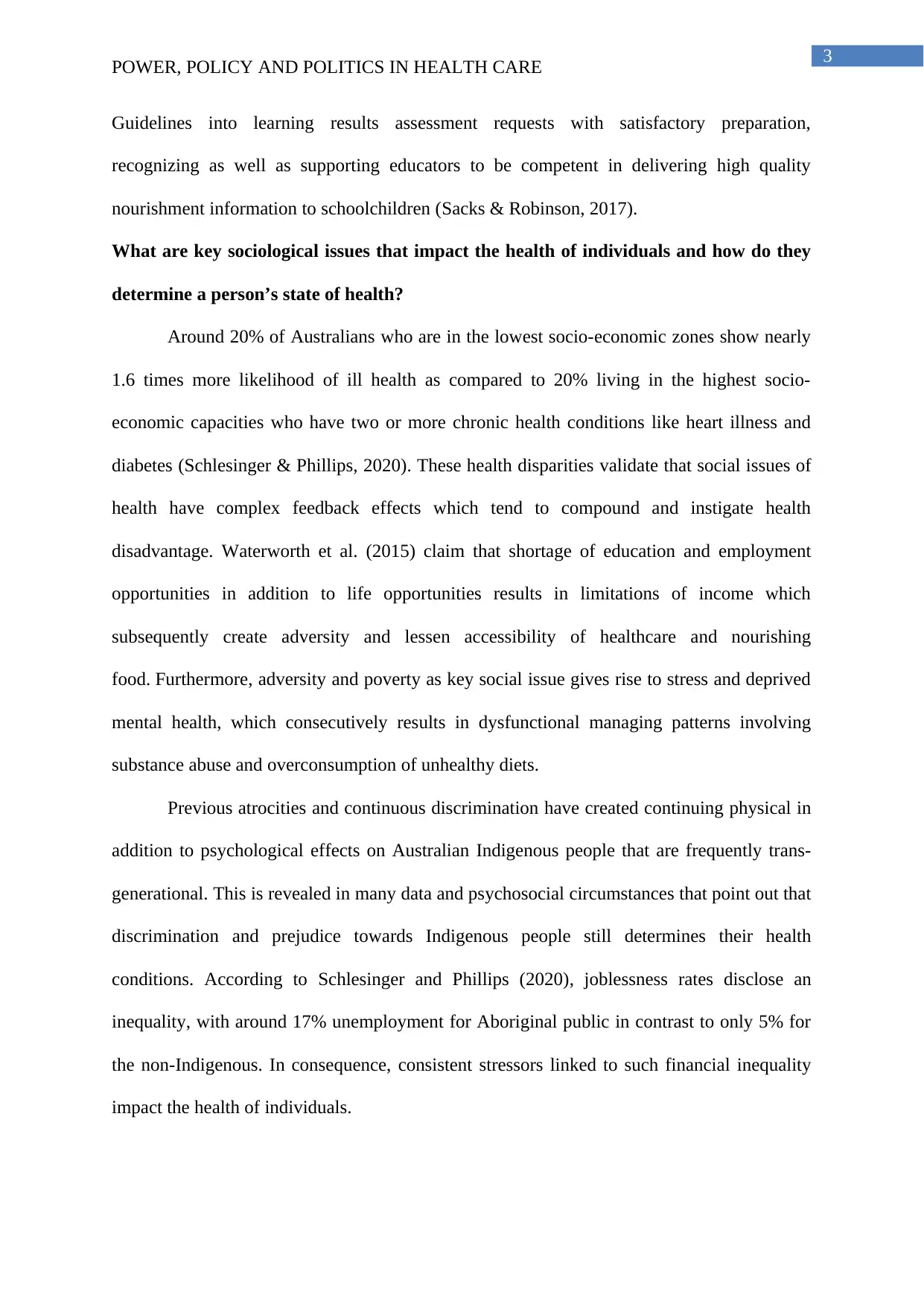
3
POWER, POLICY AND POLITICS IN HEALTH CARE
Guidelines into learning results assessment requests with satisfactory preparation,
recognizing as well as supporting educators to be competent in delivering high quality
nourishment information to schoolchildren (Sacks & Robinson, 2017).
What are key sociological issues that impact the health of individuals and how do they
determine a person’s state of health?
Around 20% of Australians who are in the lowest socio-economic zones show nearly
1.6 times more likelihood of ill health as compared to 20% living in the highest socio-
economic capacities who have two or more chronic health conditions like heart illness and
diabetes (Schlesinger & Phillips, 2020). These health disparities validate that social issues of
health have complex feedback effects which tend to compound and instigate health
disadvantage. Waterworth et al. (2015) claim that shortage of education and employment
opportunities in addition to life opportunities results in limitations of income which
subsequently create adversity and lessen accessibility of healthcare and nourishing
food. Furthermore, adversity and poverty as key social issue gives rise to stress and deprived
mental health, which consecutively results in dysfunctional managing patterns involving
substance abuse and overconsumption of unhealthy diets.
Previous atrocities and continuous discrimination have created continuing physical in
addition to psychological effects on Australian Indigenous people that are frequently trans-
generational. This is revealed in many data and psychosocial circumstances that point out that
discrimination and prejudice towards Indigenous people still determines their health
conditions. According to Schlesinger and Phillips (2020), joblessness rates disclose an
inequality, with around 17% unemployment for Aboriginal public in contrast to only 5% for
the non-Indigenous. In consequence, consistent stressors linked to such financial inequality
impact the health of individuals.
POWER, POLICY AND POLITICS IN HEALTH CARE
Guidelines into learning results assessment requests with satisfactory preparation,
recognizing as well as supporting educators to be competent in delivering high quality
nourishment information to schoolchildren (Sacks & Robinson, 2017).
What are key sociological issues that impact the health of individuals and how do they
determine a person’s state of health?
Around 20% of Australians who are in the lowest socio-economic zones show nearly
1.6 times more likelihood of ill health as compared to 20% living in the highest socio-
economic capacities who have two or more chronic health conditions like heart illness and
diabetes (Schlesinger & Phillips, 2020). These health disparities validate that social issues of
health have complex feedback effects which tend to compound and instigate health
disadvantage. Waterworth et al. (2015) claim that shortage of education and employment
opportunities in addition to life opportunities results in limitations of income which
subsequently create adversity and lessen accessibility of healthcare and nourishing
food. Furthermore, adversity and poverty as key social issue gives rise to stress and deprived
mental health, which consecutively results in dysfunctional managing patterns involving
substance abuse and overconsumption of unhealthy diets.
Previous atrocities and continuous discrimination have created continuing physical in
addition to psychological effects on Australian Indigenous people that are frequently trans-
generational. This is revealed in many data and psychosocial circumstances that point out that
discrimination and prejudice towards Indigenous people still determines their health
conditions. According to Schlesinger and Phillips (2020), joblessness rates disclose an
inequality, with around 17% unemployment for Aboriginal public in contrast to only 5% for
the non-Indigenous. In consequence, consistent stressors linked to such financial inequality
impact the health of individuals.
Paraphrase This Document
Need a fresh take? Get an instant paraphrase of this document with our AI Paraphraser
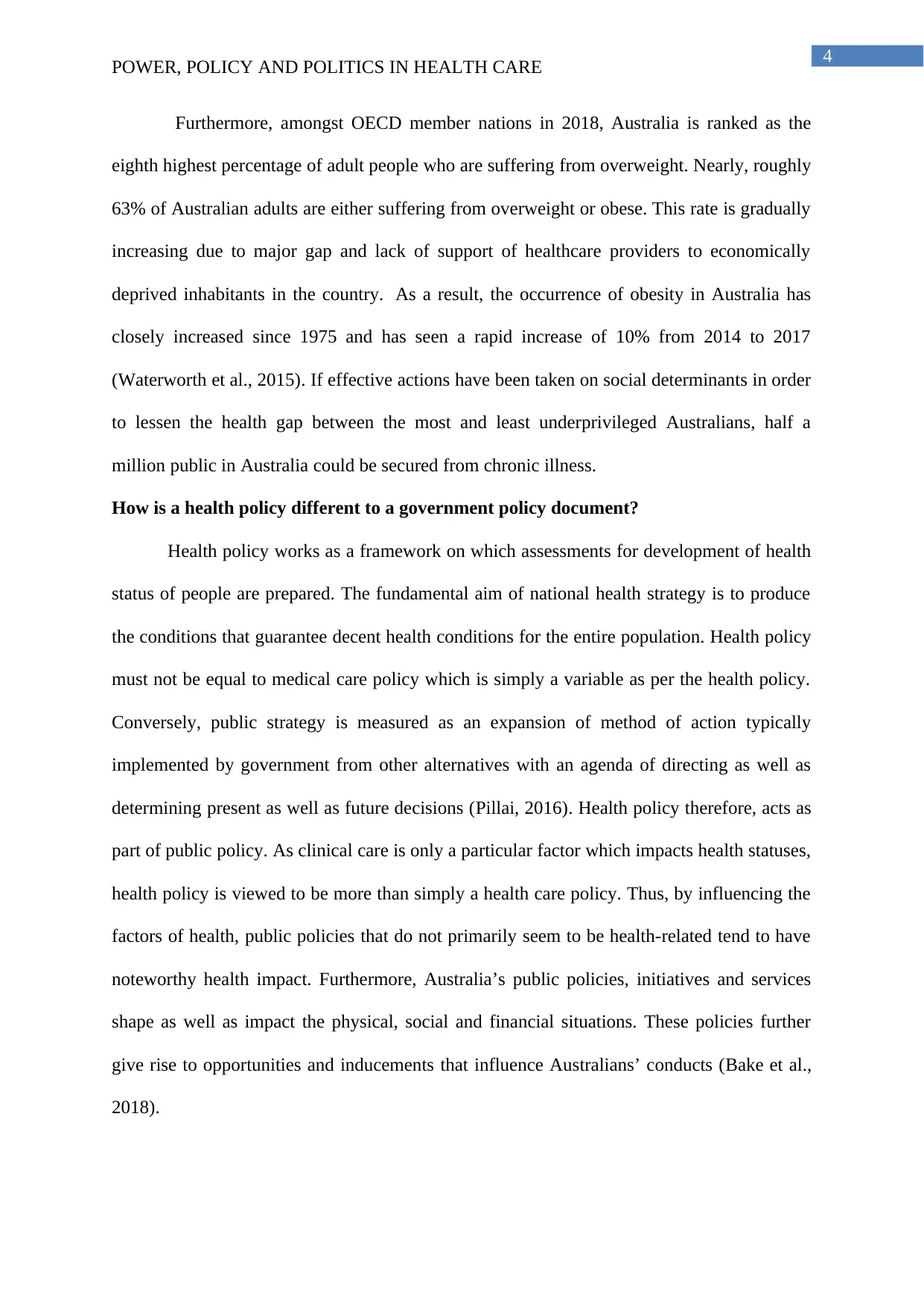
4
POWER, POLICY AND POLITICS IN HEALTH CARE
Furthermore, amongst OECD member nations in 2018, Australia is ranked as the
eighth highest percentage of adult people who are suffering from overweight. Nearly, roughly
63% of Australian adults are either suffering from overweight or obese. This rate is gradually
increasing due to major gap and lack of support of healthcare providers to economically
deprived inhabitants in the country. As a result, the occurrence of obesity in Australia has
closely increased since 1975 and has seen a rapid increase of 10% from 2014 to 2017
(Waterworth et al., 2015). If effective actions have been taken on social determinants in order
to lessen the health gap between the most and least underprivileged Australians, half a
million public in Australia could be secured from chronic illness.
How is a health policy different to a government policy document?
Health policy works as a framework on which assessments for development of health
status of people are prepared. The fundamental aim of national health strategy is to produce
the conditions that guarantee decent health conditions for the entire population. Health policy
must not be equal to medical care policy which is simply a variable as per the health policy.
Conversely, public strategy is measured as an expansion of method of action typically
implemented by government from other alternatives with an agenda of directing as well as
determining present as well as future decisions (Pillai, 2016). Health policy therefore, acts as
part of public policy. As clinical care is only a particular factor which impacts health statuses,
health policy is viewed to be more than simply a health care policy. Thus, by influencing the
factors of health, public policies that do not primarily seem to be health-related tend to have
noteworthy health impact. Furthermore, Australia’s public policies, initiatives and services
shape as well as impact the physical, social and financial situations. These policies further
give rise to opportunities and inducements that influence Australians’ conducts (Bake et al.,
2018).
POWER, POLICY AND POLITICS IN HEALTH CARE
Furthermore, amongst OECD member nations in 2018, Australia is ranked as the
eighth highest percentage of adult people who are suffering from overweight. Nearly, roughly
63% of Australian adults are either suffering from overweight or obese. This rate is gradually
increasing due to major gap and lack of support of healthcare providers to economically
deprived inhabitants in the country. As a result, the occurrence of obesity in Australia has
closely increased since 1975 and has seen a rapid increase of 10% from 2014 to 2017
(Waterworth et al., 2015). If effective actions have been taken on social determinants in order
to lessen the health gap between the most and least underprivileged Australians, half a
million public in Australia could be secured from chronic illness.
How is a health policy different to a government policy document?
Health policy works as a framework on which assessments for development of health
status of people are prepared. The fundamental aim of national health strategy is to produce
the conditions that guarantee decent health conditions for the entire population. Health policy
must not be equal to medical care policy which is simply a variable as per the health policy.
Conversely, public strategy is measured as an expansion of method of action typically
implemented by government from other alternatives with an agenda of directing as well as
determining present as well as future decisions (Pillai, 2016). Health policy therefore, acts as
part of public policy. As clinical care is only a particular factor which impacts health statuses,
health policy is viewed to be more than simply a health care policy. Thus, by influencing the
factors of health, public policies that do not primarily seem to be health-related tend to have
noteworthy health impact. Furthermore, Australia’s public policies, initiatives and services
shape as well as impact the physical, social and financial situations. These policies further
give rise to opportunities and inducements that influence Australians’ conducts (Bake et al.,
2018).
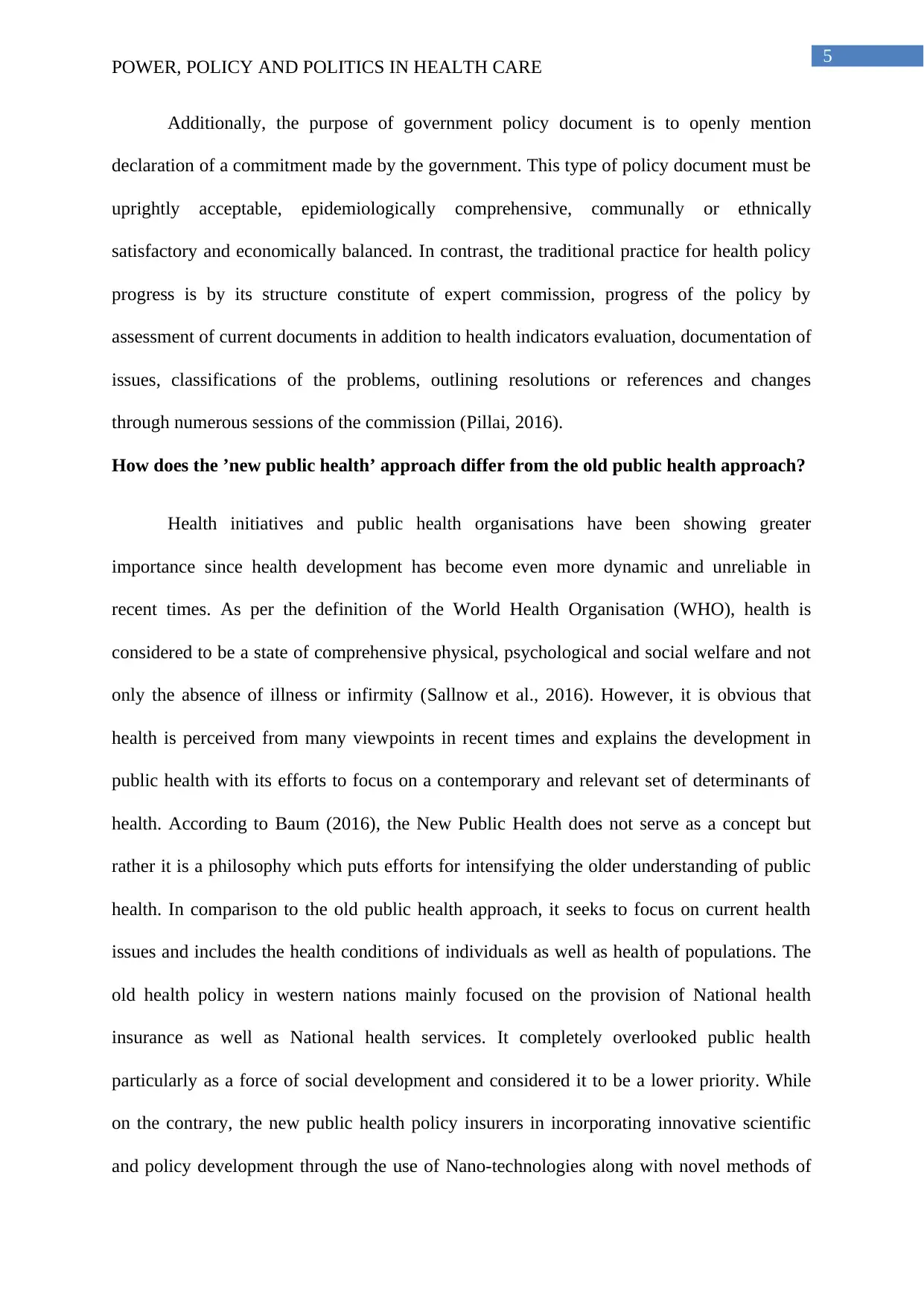
5
POWER, POLICY AND POLITICS IN HEALTH CARE
Additionally, the purpose of government policy document is to openly mention
declaration of a commitment made by the government. This type of policy document must be
uprightly acceptable, epidemiologically comprehensive, communally or ethnically
satisfactory and economically balanced. In contrast, the traditional practice for health policy
progress is by its structure constitute of expert commission, progress of the policy by
assessment of current documents in addition to health indicators evaluation, documentation of
issues, classifications of the problems, outlining resolutions or references and changes
through numerous sessions of the commission (Pillai, 2016).
How does the ’new public health’ approach differ from the old public health approach?
Health initiatives and public health organisations have been showing greater
importance since health development has become even more dynamic and unreliable in
recent times. As per the definition of the World Health Organisation (WHO), health is
considered to be a state of comprehensive physical, psychological and social welfare and not
only the absence of illness or infirmity (Sallnow et al., 2016). However, it is obvious that
health is perceived from many viewpoints in recent times and explains the development in
public health with its efforts to focus on a contemporary and relevant set of determinants of
health. According to Baum (2016), the New Public Health does not serve as a concept but
rather it is a philosophy which puts efforts for intensifying the older understanding of public
health. In comparison to the old public health approach, it seeks to focus on current health
issues and includes the health conditions of individuals as well as health of populations. The
old health policy in western nations mainly focused on the provision of National health
insurance as well as National health services. It completely overlooked public health
particularly as a force of social development and considered it to be a lower priority. While
on the contrary, the new public health policy insurers in incorporating innovative scientific
and policy development through the use of Nano-technologies along with novel methods of
POWER, POLICY AND POLITICS IN HEALTH CARE
Additionally, the purpose of government policy document is to openly mention
declaration of a commitment made by the government. This type of policy document must be
uprightly acceptable, epidemiologically comprehensive, communally or ethnically
satisfactory and economically balanced. In contrast, the traditional practice for health policy
progress is by its structure constitute of expert commission, progress of the policy by
assessment of current documents in addition to health indicators evaluation, documentation of
issues, classifications of the problems, outlining resolutions or references and changes
through numerous sessions of the commission (Pillai, 2016).
How does the ’new public health’ approach differ from the old public health approach?
Health initiatives and public health organisations have been showing greater
importance since health development has become even more dynamic and unreliable in
recent times. As per the definition of the World Health Organisation (WHO), health is
considered to be a state of comprehensive physical, psychological and social welfare and not
only the absence of illness or infirmity (Sallnow et al., 2016). However, it is obvious that
health is perceived from many viewpoints in recent times and explains the development in
public health with its efforts to focus on a contemporary and relevant set of determinants of
health. According to Baum (2016), the New Public Health does not serve as a concept but
rather it is a philosophy which puts efforts for intensifying the older understanding of public
health. In comparison to the old public health approach, it seeks to focus on current health
issues and includes the health conditions of individuals as well as health of populations. The
old health policy in western nations mainly focused on the provision of National health
insurance as well as National health services. It completely overlooked public health
particularly as a force of social development and considered it to be a lower priority. While
on the contrary, the new public health policy insurers in incorporating innovative scientific
and policy development through the use of Nano-technologies along with novel methods of
⊘ This is a preview!⊘
Do you want full access?
Subscribe today to unlock all pages.

Trusted by 1+ million students worldwide
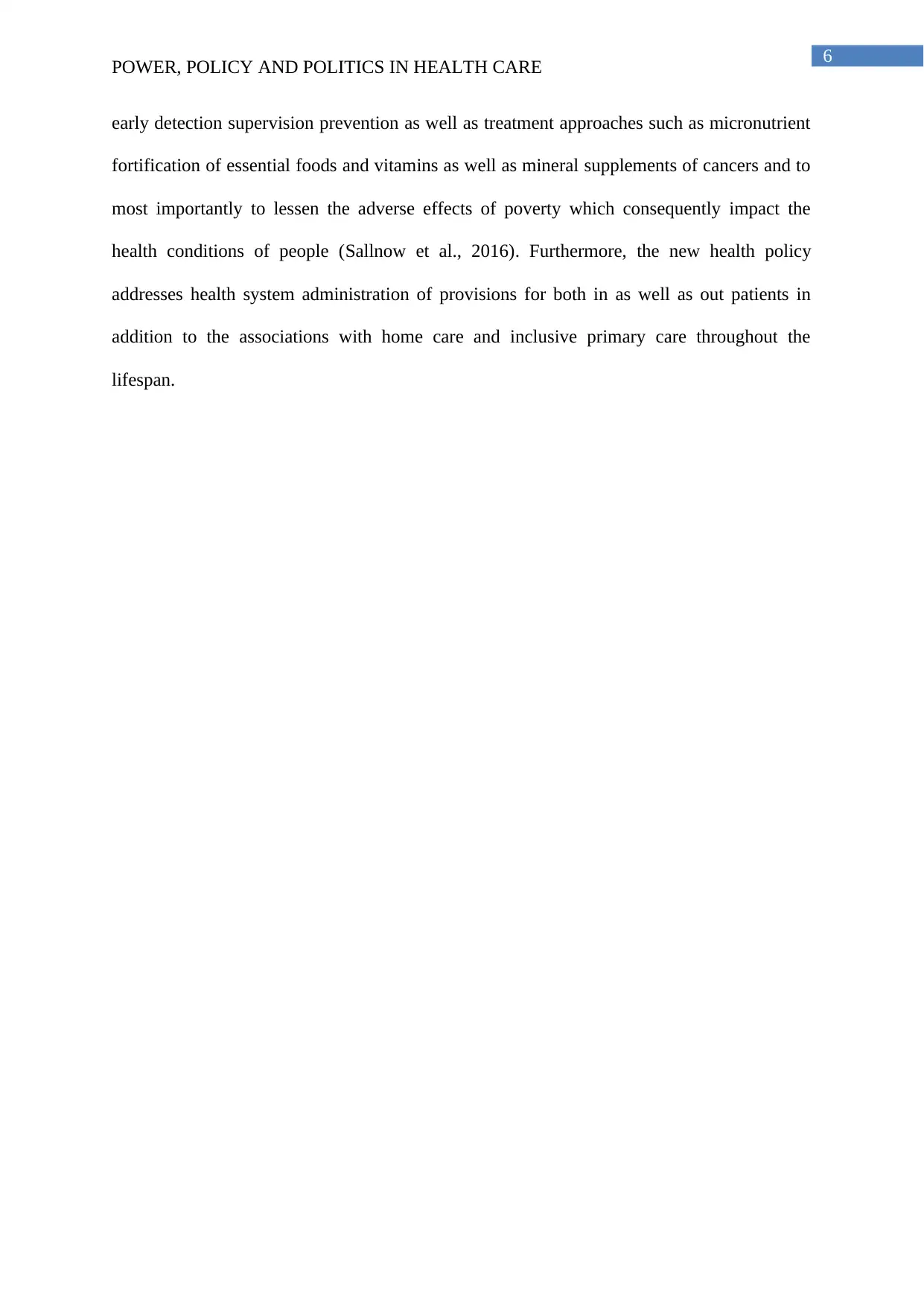
6
POWER, POLICY AND POLITICS IN HEALTH CARE
early detection supervision prevention as well as treatment approaches such as micronutrient
fortification of essential foods and vitamins as well as mineral supplements of cancers and to
most importantly to lessen the adverse effects of poverty which consequently impact the
health conditions of people (Sallnow et al., 2016). Furthermore, the new health policy
addresses health system administration of provisions for both in as well as out patients in
addition to the associations with home care and inclusive primary care throughout the
lifespan.
POWER, POLICY AND POLITICS IN HEALTH CARE
early detection supervision prevention as well as treatment approaches such as micronutrient
fortification of essential foods and vitamins as well as mineral supplements of cancers and to
most importantly to lessen the adverse effects of poverty which consequently impact the
health conditions of people (Sallnow et al., 2016). Furthermore, the new health policy
addresses health system administration of provisions for both in as well as out patients in
addition to the associations with home care and inclusive primary care throughout the
lifespan.
Paraphrase This Document
Need a fresh take? Get an instant paraphrase of this document with our AI Paraphraser
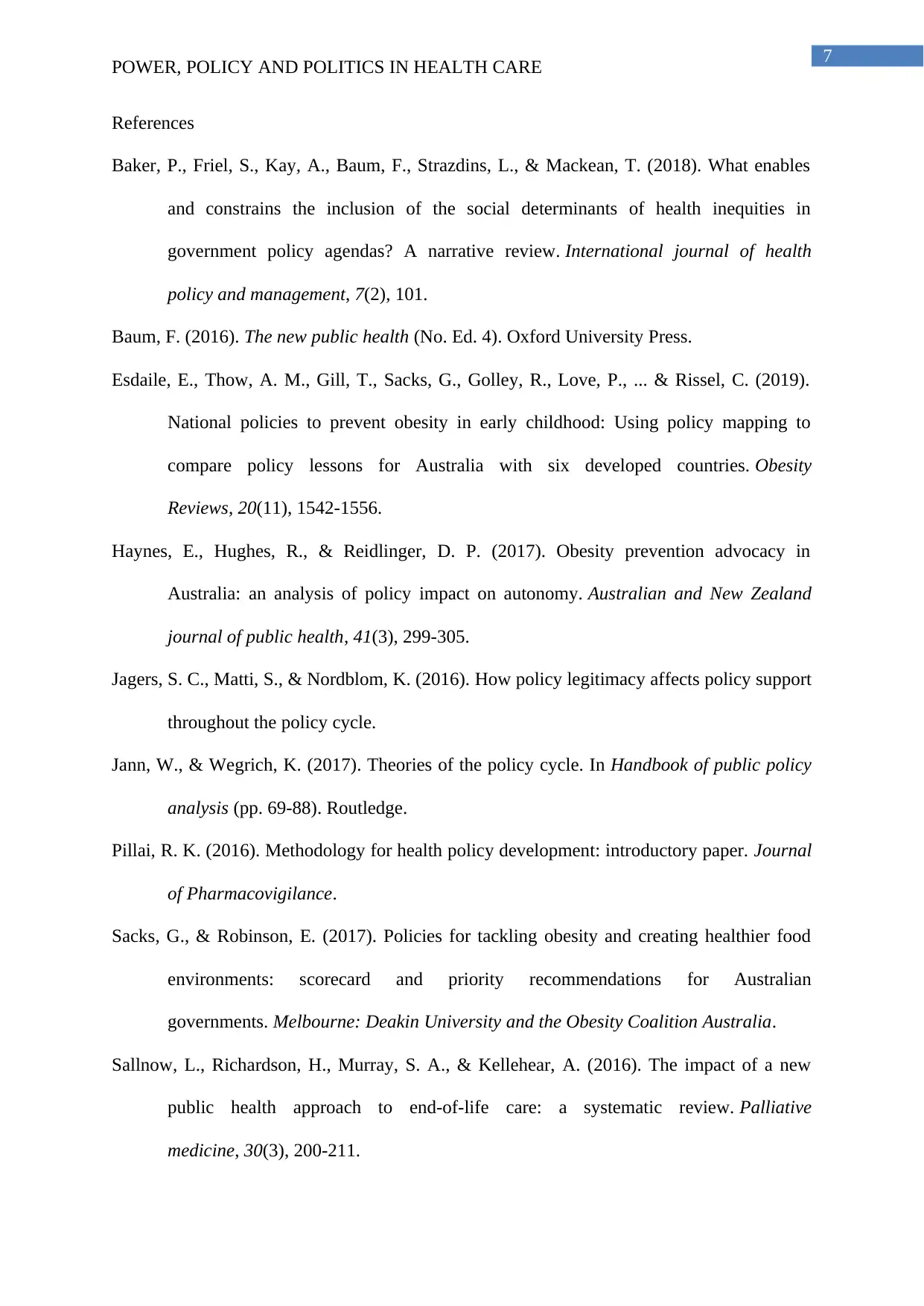
7
POWER, POLICY AND POLITICS IN HEALTH CARE
References
Baker, P., Friel, S., Kay, A., Baum, F., Strazdins, L., & Mackean, T. (2018). What enables
and constrains the inclusion of the social determinants of health inequities in
government policy agendas? A narrative review. International journal of health
policy and management, 7(2), 101.
Baum, F. (2016). The new public health (No. Ed. 4). Oxford University Press.
Esdaile, E., Thow, A. M., Gill, T., Sacks, G., Golley, R., Love, P., ... & Rissel, C. (2019).
National policies to prevent obesity in early childhood: Using policy mapping to
compare policy lessons for Australia with six developed countries. Obesity
Reviews, 20(11), 1542-1556.
Haynes, E., Hughes, R., & Reidlinger, D. P. (2017). Obesity prevention advocacy in
Australia: an analysis of policy impact on autonomy. Australian and New Zealand
journal of public health, 41(3), 299-305.
Jagers, S. C., Matti, S., & Nordblom, K. (2016). How policy legitimacy affects policy support
throughout the policy cycle.
Jann, W., & Wegrich, K. (2017). Theories of the policy cycle. In Handbook of public policy
analysis (pp. 69-88). Routledge.
Pillai, R. K. (2016). Methodology for health policy development: introductory paper. Journal
of Pharmacovigilance.
Sacks, G., & Robinson, E. (2017). Policies for tackling obesity and creating healthier food
environments: scorecard and priority recommendations for Australian
governments. Melbourne: Deakin University and the Obesity Coalition Australia.
Sallnow, L., Richardson, H., Murray, S. A., & Kellehear, A. (2016). The impact of a new
public health approach to end-of-life care: a systematic review. Palliative
medicine, 30(3), 200-211.
POWER, POLICY AND POLITICS IN HEALTH CARE
References
Baker, P., Friel, S., Kay, A., Baum, F., Strazdins, L., & Mackean, T. (2018). What enables
and constrains the inclusion of the social determinants of health inequities in
government policy agendas? A narrative review. International journal of health
policy and management, 7(2), 101.
Baum, F. (2016). The new public health (No. Ed. 4). Oxford University Press.
Esdaile, E., Thow, A. M., Gill, T., Sacks, G., Golley, R., Love, P., ... & Rissel, C. (2019).
National policies to prevent obesity in early childhood: Using policy mapping to
compare policy lessons for Australia with six developed countries. Obesity
Reviews, 20(11), 1542-1556.
Haynes, E., Hughes, R., & Reidlinger, D. P. (2017). Obesity prevention advocacy in
Australia: an analysis of policy impact on autonomy. Australian and New Zealand
journal of public health, 41(3), 299-305.
Jagers, S. C., Matti, S., & Nordblom, K. (2016). How policy legitimacy affects policy support
throughout the policy cycle.
Jann, W., & Wegrich, K. (2017). Theories of the policy cycle. In Handbook of public policy
analysis (pp. 69-88). Routledge.
Pillai, R. K. (2016). Methodology for health policy development: introductory paper. Journal
of Pharmacovigilance.
Sacks, G., & Robinson, E. (2017). Policies for tackling obesity and creating healthier food
environments: scorecard and priority recommendations for Australian
governments. Melbourne: Deakin University and the Obesity Coalition Australia.
Sallnow, L., Richardson, H., Murray, S. A., & Kellehear, A. (2016). The impact of a new
public health approach to end-of-life care: a systematic review. Palliative
medicine, 30(3), 200-211.
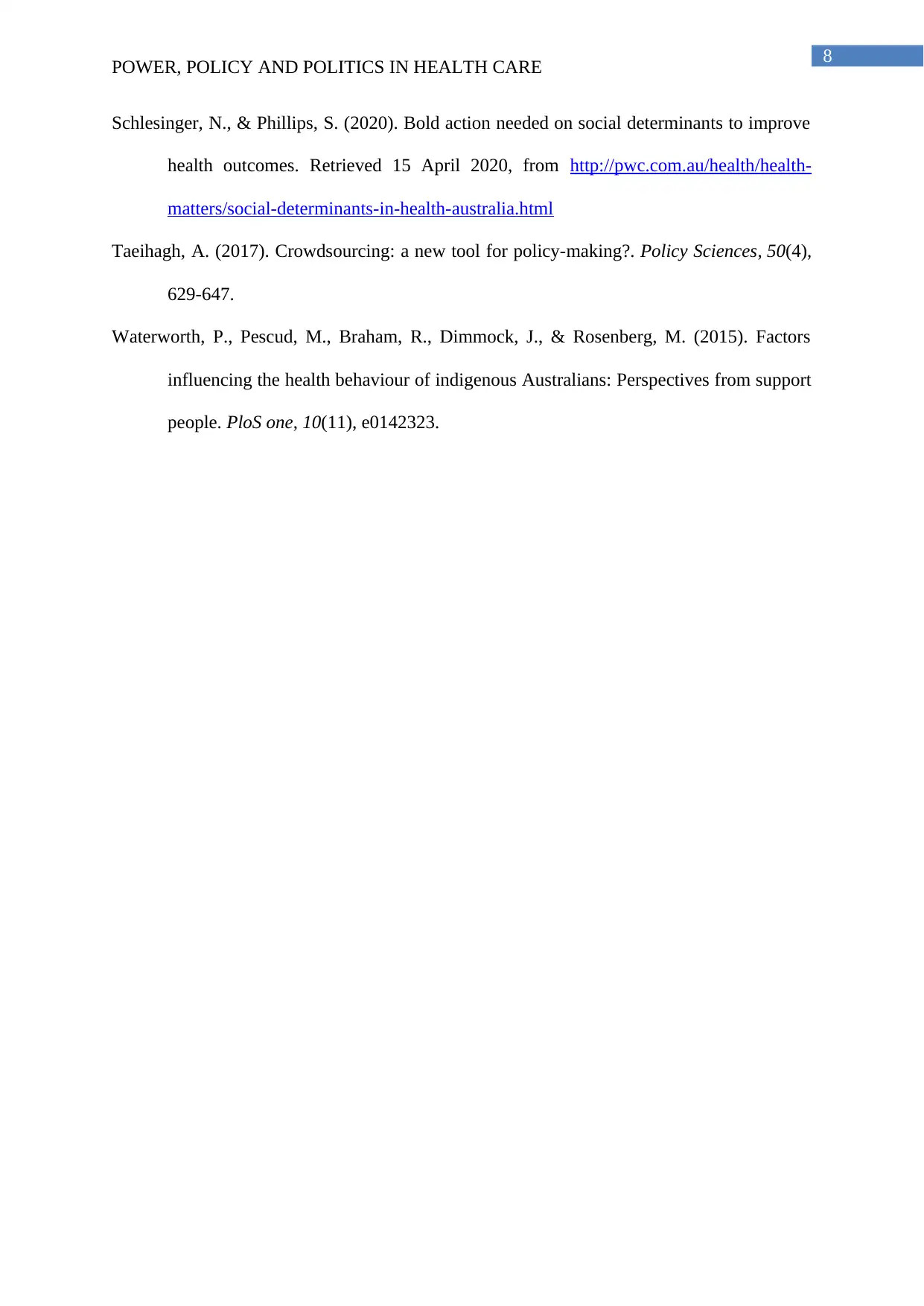
8
POWER, POLICY AND POLITICS IN HEALTH CARE
Schlesinger, N., & Phillips, S. (2020). Bold action needed on social determinants to improve
health outcomes. Retrieved 15 April 2020, from http://pwc.com.au/health/health-
matters/social-determinants-in-health-australia.html
Taeihagh, A. (2017). Crowdsourcing: a new tool for policy-making?. Policy Sciences, 50(4),
629-647.
Waterworth, P., Pescud, M., Braham, R., Dimmock, J., & Rosenberg, M. (2015). Factors
influencing the health behaviour of indigenous Australians: Perspectives from support
people. PloS one, 10(11), e0142323.
POWER, POLICY AND POLITICS IN HEALTH CARE
Schlesinger, N., & Phillips, S. (2020). Bold action needed on social determinants to improve
health outcomes. Retrieved 15 April 2020, from http://pwc.com.au/health/health-
matters/social-determinants-in-health-australia.html
Taeihagh, A. (2017). Crowdsourcing: a new tool for policy-making?. Policy Sciences, 50(4),
629-647.
Waterworth, P., Pescud, M., Braham, R., Dimmock, J., & Rosenberg, M. (2015). Factors
influencing the health behaviour of indigenous Australians: Perspectives from support
people. PloS one, 10(11), e0142323.
⊘ This is a preview!⊘
Do you want full access?
Subscribe today to unlock all pages.

Trusted by 1+ million students worldwide
1 out of 9
Related Documents
Your All-in-One AI-Powered Toolkit for Academic Success.
+13062052269
info@desklib.com
Available 24*7 on WhatsApp / Email
![[object Object]](/_next/static/media/star-bottom.7253800d.svg)
Unlock your academic potential
Copyright © 2020–2025 A2Z Services. All Rights Reserved. Developed and managed by ZUCOL.




